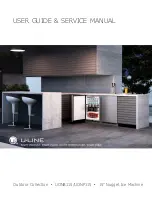
ENGLISH
3
* The Strainer must be cleaned periodically.
[Icemaker Connections]
1) Attach the angled end of white flexible inlet hose (accessory) to
the G3/4 fitting on the rear of the icemaker as indicated, ensuring
rubber sealing washer is correctly positioned. Hand tighten
sufficiently to provide leak free joint.
2) Attach the other end of inlet hose to the water tap (Fig. 5), noting
washer is correctly positioned before hand tightening as above.
Note: If filtration or treatment is used, ensure icemaker section only
is on treated water supply, not the Condenser.
3) Attach grey flexible outlet hose (accessory) to the R3/4 fitting on
the rear of the icemaker as indicated, confirming fitment of rubber
washer before finally hand tightening the joint. This pipe can be cut
to length as necessary to suit position of main drain (Fig. 3).
4) By means of a suitable spanner or wrench, tighten the 1/2-
3/4 nipples (accessory) into the Rc1/2 fittings on the rear of the
icemaker as indicated. P.T.F.E. tape and/or a suitable sealing
compound should be used to obtain a leak free joint.
Note: Jointing compounds should be approved and suitable for
potable water use.
5) Connect the Condenser cooling circuit to the free ends of 1/2-3/4
nipples as indicated (Fig. 6), using a suitable rigid type pipe. P.T.F.E.
tape and/or a suitable sealing compound should be used to obtain
a leak free joint.
Fig. 6
Potable Water
Inlet G3/4
Inlet Hose
Drain Outlet R3/4
Outlet Hose
Cooling Water
Inlet Rc1/2
Cooling Water
Outlet Rc1/2
1/2-3/4 Nipple
Condenser Cooling Circuit
Fig. 7
Icemaker
Cooling
Tower
Flow Control Valve
Strainer
Pump
P
Fig. 8
Potable Water
Inlet G3/4
Inlet Hose
Outlet Hose
Inlet Hose
Drain Outlet R3/4
Cooling Water
Inlet Rc1/2
Cooling Water
Outlet Rc1/2
1/2-3/4 Nipple
[b] Connections according to regulations other than WRC by
utilising accessory hoses (Fig. 8)
1) Follow the instructions from 1) to 4) in [a] above.
2) For Condenser connections, use supplied accessory hoses and
make the same connections as 1) to 3) in [a] above to the free
ends of 1/2-3/4 nipples as indicated (Fig. 8).
II. OPERATING INSTRUCTIONS
WARNING
1. This icemaker is designed to produce and store edible ice. To
keep the icemaker hygienic:
* Wash your hands before removing ice. Use the Plastic
Scoop provided (accessory).
* The Storage Bin is for ice use only. Do not store anything
else in the Bin.
* Clean the Storage Bin before use (see “III. 1. CLEANING”).
* Keep the Scoop clean. Clean it by using a neutral cleaner
and rinse thoroughly.
* Close the Door after removing ice to prevent entrance of
dirt, dust or insects into the Storage Bin.
2. The use of any electrical equipment involves the observance
of some fundamental rules. In particular:
* Instances of high humidity and moisture increase the risk
of electrical short circuits and potential electrical shocks. If
in doubt, disconnect the icemaker.
* Do not pull the power cord in order to disconnect the
icemaker from the feed network.
* This appliance is not suitable for household and similar
use, but is intended for commercial use only.
3. All parts are factory-adjusted. Improper adjustments may
result in failure.
4. If the unit is turned off, wait for at least 3 minutes before
restarting the icemaker to prevent damage to the
Compressor.
1. OPERATION
The installer will normally commission the icemaker to start the
automatic icemaking process. To ensure continuous operation, make
sure that:





































